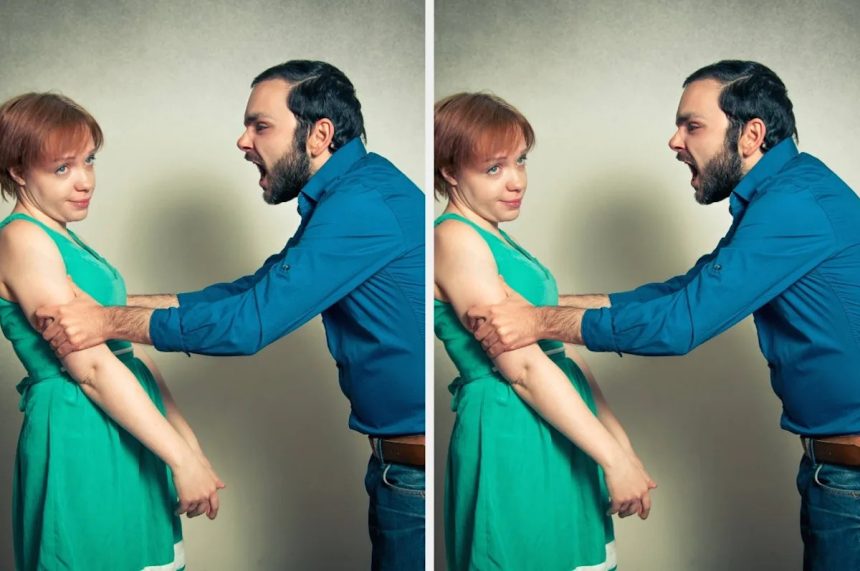This scene plays out so many times: A woman is out at a bar when a man approaches her and acts in a manner that makes her uncomfortable. She tries to get him to go away, but he doesn’t take the hint. She quickly scans the room looking for help, but everyone else drinks, chats, and goes about their night.
Zoranm / Getty Images
Many women have stories of an unwanted encounter, whether it’s at school, at work or out at a party. And they’re often left to fend for themselves while bystanders — especially men — look away, scroll their phones, or pretend not to notice, taking part in what’s called “the bystander effect.”
“The bystander effect describes the general tendency for people to be less likely to speak up or act in a group setting when more people are present in the situation,” Catherine Sanderson, a professor of psychology at Amherst College and author of Why We Act: Turning Bystanders Into Moral Rebels, told HuffPost.

Godong / Getty Images
While both men and women can fall victim to being bystanders, a 2022 systematic review found that women are more likely to intervene in these kinds of situations than men. Another study from 2016 concluded that different masculine norms may influence men’s willingness to intervene, such as confusion over what’s acceptable behavior or fear of what their social peers may think if they spoke up.
But of course, speaking out against any harmful situation is not only the right thing to do, it can save lives. “When masculinity gets defined as dominance or toughness, stepping in can feel like a trap. If you call out another guy, you risk being seen as soft,” said Ron Burg, PhD, Licensed Psychologist. “A healthier way to frame masculinity is as protecting the safety of the community. It’s not about shaming the other guy; it’s about showing that in your space, respect matters.”

Maskot / Getty Images
1. Behind the Silence? Socialization

Hoozone / Getty Images
Advertisement
Advertisement
So why aren’t men speaking up more? First, some situations are ambiguous, Sanderson said, such as recognizing whether a comment is actually a compliment or harassment. When that happens, people fear acting stupid or overreacting, so they start looking toward each other to see how to respond.
“No one may step up even if many people find a particular comment or behavior problematic,” she added.
Gender socialization also plays a role in what men even consider problematic. “[Men are] often socialized to brush off certain behaviors as ‘just flirting’ or ‘guys being guys,’ which means they may not even register [a situation] as a problem in the first place,” Burg explained. “That doesn’t mean they’re intentionally ignoring it — it means their internal filter has been shaped to minimize it.”

Estradaanton / Getty Images
Related: Medical Professionals Are Sharing “Mundane” Things That Actually Make So Many People Sick
When many people are present in a situation where any one of them could intervene, each person doesn’t feel personally compelled to step up, Sanderson explained.
The setting matters too. In public spaces like bars, streets or transit, Burg notes that “things usually happen quickly and without much context.” That distance and anonymity make it easier to tell yourself it’s not your problem.
In workplaces or schools, power dynamics can also cause people to hesitate ― they worry about HR, grades or social repercussions, but there’s also a stronger chance that someone will act because relationships are often personal.
“If you know the person being harassed or you’re friends with them, that familiarity can cut through the bystander freeze,” Burg said.

Zoranm / Getty Images
Lastly, people fear the consequences of speaking up, especially if it’s against someone powerful. “Sometimes stepping up can lead to physical harm,” Sanderson said. “Sometimes acting can lead people to experience social consequences, such as losing friends or even their careers.”
2. What the Bystander Freeze Excuses

Skynesher / Getty Images
“In tight-knit groups, such as athletic teams, people feel considerable pressure to show loyalty to other group members,” Sanderson added. “This sometimes translates into staying silent in the face of bad behavior by their peers — sticking together, regardless of right or wrong.”
For men specifically, these dynamics get amplified by gender norms and peer pressure. “There’s the fear of retaliation, sure, but also the fear of social pushback from other men — getting called dramatic, weak or ‘uncool,’” Burg added. “And conformity is powerful. If the group is laughing something off, many men follow along even if they feel uncomfortable.”
However, Burg suggests thinking twice about what loyalty entails: “I’d argue real loyalty means pulling your friend back when he’s about to cross a line, not letting him embarrass himself or hurt someone else. A quick ‘Hey man, let’s step outside’ can actually be an act of loyalty.”

Seventyfour / Getty Images
Advertisement
Advertisement
One of the most insidious aspects of bystander silence that Burg highlights is how many men minimize behavior that may rise to violence: “Men will say, ‘He’s just drunk,’ or, ‘He’s just flirting.’ The problem is that these behaviors don’t usually stop on their own — they escalate.”
Cultural messages also don’t help. Generations of “mind your own business” and “boys will be boys” have taught men to stay out of it and to excuse bad behavior. “They tell men that if they step in, they’re meddling and that what the harasser is doing is somehow just part of ‘being a guy,’” Burg says.
3. Not Just a Call-Out, But “Calling Your Values Up”

Ryan Mcvay / Getty Images
Related: People Are Sharing The “Harmless” Habits That Changed Their Bodies Forever
“Stepping in isn’t about calling someone out — it’s about calling your values up,” Burg said. “Most of the time, intervening takes little time and involves minimal risk, but it can mean everything to the person being targeted.”
According to Burg, the easiest time to intervene, as you notice an encounter feeling “off,” is actually the safest time to step in. Start by redirecting the conversation, saying something like, “Did you catch the game last night?” or commenting about the bar. Then, ask the person being targeted if they need help and assure them you’re around if things get out of hand.
Other strategies include involving others in the area, such as staff or security, especially if the situation appears intense. Or even a simple direct message, like, “Hey, not cool,” to the person doing the harassing, goes a long way.

Solstock / Getty Images
Burg suggests building these habits into daily life: “Practice reading the room. Pay attention to body language when you’re out, and get in the habit of noticing when someone looks uncomfortable. That awareness is a skill you can sharpen, and it makes stepping in feel less like a leap and more like a natural extension of what you’ve already observed.”
Bystander intervention programs combining several elements can be effective, Burg adds. In fact, a 2018 review involving student participation in bystander intervention programs across Kentucky high schools saw a gradual decrease in sexual and dating violence acceptance.Programs such as Bringing in the Bystander and Green Dot help individuals increase their knowledge about what harassment looks like, shift their attitudes toward less tolerance of sexist behavior and improve their confidence in intervening.
“I think we all want to live in a world in which more people speak up in the face of problematic behavior,” Sanderson said, adding that another great way to stand up to violence or harassment is to think about how it would feel if this happened to someone in their own life. “Would they want the women in their lives to be harassed? If not, they have a responsibility to act to shift social norms and to define being a man as being brave enough to speak up, no matter the costs.”

Backiris / Getty Images
This article originally appeared on HuffPost.
Also in Goodful: “My Husband Was Shocked”: Women Are Sharing The Everyday Routines And Practices They Do In Private That Have Men Incredibly Baffled
Also in Goodful: “That’s The Greenest Flag I Could Think Of”: 16 Very Subtle Behaviors That Signal Someone Is A Really, Really Good Person
Also in Goodful: Medical Professionals Are Calling Out The Biggest “Mistakes” People Make All The Time While Trying To Improve Their Health









